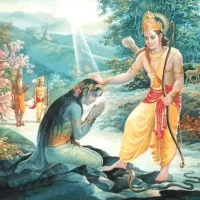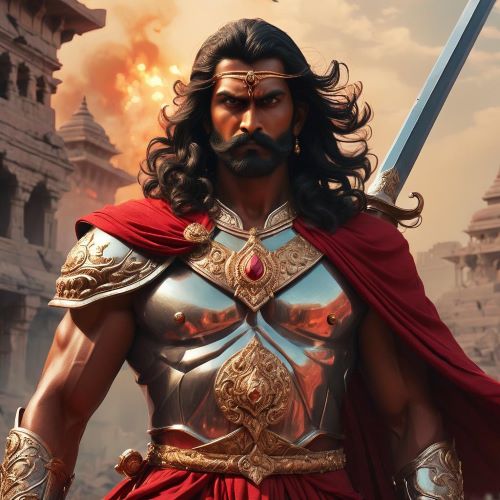Ahalya : The Cursed Beauty
Listen
At a glance
| Description | |
|---|---|
| Origin | Indian Mythology |
| Classification | Mortals |
| Family Members | Gautama Maharishi (Husband), Shatananda (Son) |
| Region | India |
| Associated With | Curse |
Ahalya
Introduction
Ahalya stands as one of the most poignant and multifaceted figures in Indian mythology. Revered as one of the Panchakanya—the five sacred women whose names are recited to dispel sin—her tale embodies themes of beauty, deception, punishment, and redemption. Found primarily in the Ramayana and later Puranic and regional retellings, Ahalya’s legend continues to evoke debates around morality, gender, and divine grace. She is best known as the wife of Sage Gautama Maharishi and the woman whom Indra, king of the gods, deceived in disguise. Cursed by her husband and later redeemed by Rama, Ahalya’s journey from transgression to salvation remains one of Hinduism’s most powerful allegories of transformation.
Physical Traits
Ahalya’s creation itself sets her apart from mortal women. She was not born of a mother but crafted by Brahma, the creator god, from the purest elements of beauty and perfection. Her very name comes from the Sanskrit root “Ahal,” meaning “unploughed” or “undefiled,” symbolizing purity, flawlessness, and divine craftsmanship. Texts such as the Valmiki Ramayana describe her as radiant and ethereal, her beauty compared to the dawn or the glow of sacred fire. She was said to possess a luminous complexion, soft features, and an aura that reflected inner serenity. This perfection, though divine in origin, became both her blessing and her curse—an irresistible attraction that drew the attention of gods and mortals alike.
In art and sculpture, Ahalya is often portrayed as a serene woman with a tranquil face, her beauty muted by sorrow and penitence. Artists across centuries have used her image to depict purity tarnished by circumstance yet ultimately restored by divine grace. Her physical form thus mirrors her spiritual journey—from unblemished creation to fall and eventual redemption.
Family
Ahalya was given in marriage to Sage Gautama Maharishi, one of the most venerated sages of his time. While some accounts say Brahma himself chose Gautama as a suitable match for her, others claim Gautama won her hand through devotion and wisdom rather than desire. Their marriage symbolized the union of divine beauty and ascetic discipline, though it also underscored the tensions between sensuality and spirituality that would define her fate.
Their only known son, Shatananda, later became the royal priest of Mithila, the kingdom of King Janaka—Sita’s father. When Rama and Lakshmana visited Mithila, it was Shatananda who narrated his mother’s story, emphasizing her eventual redemption. This familial connection situates Ahalya’s story within the broader narrative of the Ramayana, linking her directly to Sita and Rama’s divine purpose. While Ahalya’s tale revolves around betrayal and punishment, her family’s legacy—especially through Shatananda—preserves the values of wisdom and righteousness that define the epic’s moral compass.
Other names
Ahalya is also referred to as Ahilya or Ahalya Devi in various regions and scriptures. Each variation retains the essence of her purity and divine origin. The literal translation of her name—“the unploughed one”—has been interpreted both literally and symbolically. Some scholars see it as a metaphor for untouched earth, linking her to fertility and creation, while others view it as a representation of innocence and virtue. As one of the Panchakanya—alongside Draupadi, Kunti, Tara, and Mandodari—Ahalya’s name carries spiritual significance in daily recitations meant to absolve sin. Her identity thus transcends the boundaries of myth, merging the divine, the moral, and the human.
Powers and Abilities
Unlike deities or warriors in Hindu mythology, Ahalya’s powers are not physical or magical. Her strength lies in her divine creation, moral resilience, and capacity for redemption. Born of Brahma’s will, she possessed inherent grace and intuitive wisdom. In some interpretations of the myth, Ahalya recognized Indra’s disguise as Gautama but, moved by curiosity or divine influence, momentarily faltered—an act that would cost her dearly. Her awareness of the deceit, however, underscores her perception and spiritual consciousness, qualities often overlooked in earlier patriarchal readings of her story.
When Gautama discovered Indra’s deception, his anger led to Ahalya’s transformation—some say she was turned into stone, others say she became invisible, living in penance for years. Yet even in her cursed state, she remained aware, meditating and awaiting release. This endurance becomes her true power: the ability to sustain consciousness through shame, isolation, and spiritual trial. When Rama’s feet touched her, his divine energy restored her form and purified her being. The event symbolizes not merely forgiveness but spiritual rebirth—a reminder that divine grace transcends judgment.
Modern Day Influence
Ahalya’s legend continues to resonate deeply within Indian art, literature, and cinema, reflecting shifting societal attitudes toward gender and morality. In early retellings, she is portrayed as a cautionary figure—a woman punished for succumbing to desire. However, modern interpretations have reclaimed her narrative, portraying her as a victim of deceit and a symbol of unjust patriarchy. Her story is often revisited to question notions of purity, guilt, and forgiveness.
In the 2015 short film Ahalya by Sujoy Ghosh, the myth is reimagined through a feminist lens, where Ahalya becomes a powerful, autonomous figure who subverts traditional gender roles. Poets and novelists have likewise presented her as a voice of suppressed womanhood, whose “curse” reflects societal punishment of female desire. Contemporary scholars view her tale as an allegory for human frailty and the transformative power of compassion—where Rama’s touch represents not external salvation but the awakening of inner grace.
In temple traditions and devotional art, Ahalya continues to embody themes of penance and redemption. In Mithila, local versions of the story celebrate her as a goddess of renewal, her redemption serving as a metaphor for the cleansing of the soul through faith. Feminist thinkers and spiritual teachers alike interpret her legend as a reminder that divinity does not lie in perfection but in the ability to rise after one’s fall.
Related Images
Source
Wikipedia contributors. (2025). Ahalya. In Wikipedia, The Free Encyclopedia. Retrieved October 16, 2025, from https://en.wikipedia.org/wiki/Ahalya
Tell-a-Tale. (2018, January 21). The Complete Story of Ahalya. Retrieved October 16, 2025, from https://www.tell-a-tale.com/deliverance-the-story-of-ahalya/
Sirjana. (2024). Facets of Ahalya in Hindu Mythology. Sirjana: Journal of English Studies, 23. Retrieved October 16, 2025, from https://sirjana.in/wp-content/uploads/2024/02/14.SRJ23A329.pdf
Utsav App. (2025, September 20). The Story of Indra and Ahalya: A Tale of Love, Deception and Redemption. Retrieved October 16, 2025, from https://utsavapp.in/gyan/dharmik-gyan/story-of-indra-and-ahalya
Wisdom Library. (2025, July 29). Ahalya: Significance and Symbolism. Retrieved October 16, 2025, from https://www.wisdomlib.org/concept/ahalya
Simple Wikipedia contributors. (2022, July 14). Ahalya. In Simple English Wikipedia. Retrieved October 16, 2025, from https://simple.wikipedia.org/wiki/Ahalya
Indian Psychiatric Society. (2023, March). Indian Journal of Psychiatry (PDF). Retrieved October 16, 2025, from https://indianpsychiatricsociety.org/wp-content/uploads/2023/03/IJPsy_Mar_23-Issue-PDF.pdf
SlideShare. (n.d.). Story of Ahalya. Retrieved October 16, 2025, from https://www.slideshare.net/slideshow/story-of-ahalyapptx/262480436
Hindu Temple Talk. (2024, February 2). Ahalya: A Tragic Tale in Indian Mythology. https://hindutempletalk.org/2024/02/02/ahalyaa-tragic-tale-in-indian-mythology/
Doniger, W. (2009). The Hindus: An Alternative History. Penguin Books.
Pattanaik, D. (2010). Jaya: An Illustrated Retelling of the Mahabharata. Penguin India.
Narayan, R. K. (2006). The Ramayana: A Shortened Modern Prose Version of the Indian Epic. Penguin Classics.
Frequently Asked Questions
What is lorem Ipsum?
I am text block. Click edit button to change this text. Lorem ipsum dolor sit amet, consectetur adipiscing elit. Ut elit tellus, luctus nec ullamcorper mattis, pulvinar dapibus leo.
What is lorem Ipsum?
I am text block. Click edit button to change this text. Lorem ipsum dolor sit amet, consectetur adipiscing elit. Ut elit tellus, luctus nec ullamcorper mattis, pulvinar dapibus leo.
What is lorem Ipsum?
I am text block. Click edit button to change this text. Lorem ipsum dolor sit amet, consectetur adipiscing elit. Ut elit tellus, luctus nec ullamcorper mattis, pulvinar dapibus leo.
What is lorem Ipsum?
I am text block. Click edit button to change this text. Lorem ipsum dolor sit amet, consectetur adipiscing elit. Ut elit tellus, luctus nec ullamcorper mattis, pulvinar dapibus leo.
What is lorem Ipsum?
I am text block. Click edit button to change this text. Lorem ipsum dolor sit amet, consectetur adipiscing elit. Ut elit tellus, luctus nec ullamcorper mattis, pulvinar dapibus leo.













